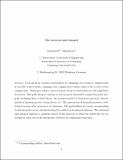| dc.contributor.author | Lloyd, Seth | |
| dc.contributor.author | Dreyer, Olaf | |
| dc.date.accessioned | 2016-06-23T22:08:39Z | |
| dc.date.available | 2017-03-01T16:14:48Z | |
| dc.date.issued | 2015-12 | |
| dc.date.submitted | 2015-02 | |
| dc.identifier.issn | 1570-0755 | |
| dc.identifier.issn | 1573-1332 | |
| dc.identifier.uri | http://hdl.handle.net/1721.1/103313 | |
| dc.description.abstract | Path integrals calculate probabilities by summing over classical configurations of variables such as fields, assigning each configuration a phase equal to the action of that configuration. This paper defines a universal path integral, which sums over all computable structures. This path integral contains as sub-integrals all possible computable path integrals, including those of field theory, the standard model of elementary particles, discrete models of quantum gravity, string theory, etc. The universal path integral possesses a well-defined measure that guarantees its finiteness. The probabilities for events corresponding to sub-integrals can be calculated using the method of decoherent histories. The universal path integral supports a quantum theory of the universe in which the world that we see around us arises out of the interference between all computable structures. | en_US |
| dc.description.sponsorship | W. M. Keck Foundation Center for Extreme Quantum Information Theory | en_US |
| dc.description.sponsorship | United States. Defense Advanced Research Projects Agency | en_US |
| dc.description.sponsorship | United States. Army Research Office. Multidisciplinary University Research Initiative | en_US |
| dc.description.sponsorship | National Science Foundation (U.S.) | en_US |
| dc.description.sponsorship | MIT Energy Initiative | en_US |
| dc.description.sponsorship | Eni S.p.A. (Firm) | en_US |
| dc.description.sponsorship | Lockheed Martin | en_US |
| dc.description.sponsorship | Foundational Questions Institute (FQXi) | en_US |
| dc.description.sponsorship | Jeffrey Epstein | en_US |
| dc.publisher | Springer US | en_US |
| dc.relation.isversionof | http://dx.doi.org/10.1007/s11128-015-1178-7 | en_US |
| dc.rights | Creative Commons Attribution-Noncommercial-Share Alike | en_US |
| dc.rights.uri | http://creativecommons.org/licenses/by-nc-sa/4.0/ | en_US |
| dc.source | Springer US | en_US |
| dc.title | The universal path integral | en_US |
| dc.type | Article | en_US |
| dc.identifier.citation | Lloyd, Seth, and Olaf Dreyer. “The Universal Path Integral.” Quantum Information Processing 15, no. 2 (December 10, 2015): 959–967. | en_US |
| dc.contributor.department | Massachusetts Institute of Technology. Department of Mechanical Engineering | en_US |
| dc.contributor.mitauthor | Lloyd, Seth | en_US |
| dc.relation.journal | Quantum Information Processing | en_US |
| dc.eprint.version | Author's final manuscript | en_US |
| dc.type.uri | http://purl.org/eprint/type/JournalArticle | en_US |
| eprint.status | http://purl.org/eprint/status/PeerReviewed | en_US |
| dc.date.updated | 2016-05-23T12:17:23Z | |
| dc.language.rfc3066 | en | |
| dc.rights.holder | Springer Science+Business Media New York | |
| dspace.orderedauthors | Lloyd, Seth; Dreyer, Olaf | en_US |
| dspace.embargo.terms | N | en |
| mit.license | OPEN_ACCESS_POLICY | en_US |
